CBSE class 10 Science Chapter 7 Control and Coordination notes in PDF are available for free download in myCBSEguide mobile app. The best app for CBSE students now provides Control and Coordination class 10 Notes latest chapter wise notes for quick preparation of CBSE board exams and school based annual examinations. Class 10 Science notes on Chapter 7 Control and Coordination are also available for download in CBSE Guide website.
CBSE Guide Control and Coordination class 10 Notes
CBSE guide notes are the comprehensive notes which covers the latest syllabus of CBSE and NCERT. It includes all the topics given in NCERT class 10 Science text book. Users can download CBSE guide quick revision notes from myCBSEguide mobile app and my CBSE guide website.
10 Science notes Chapter 7 Control and Coordination
Download CBSE class 10th revision notes for Chapter 7 Control and Coordination in PDF format for free. Download revision notes for Control and Coordination class 10 Notes and score high in exams. These are the Control and Coordination class 10 Notes prepared by team of expert teachers. The revision notes help you revise the whole chapter in minutes. Revising notes in exam days is on of the best tips recommended by teachers during exam days.
Download Revision Notes as PDF
CBSE Class 10 Science
Revision Notes
CHAPTER – 7
CONTROL AND CO-ORDINATION
Living organisms respond to various stimuli like heat, light, cold, touch, pressure etc.
Example : Withdrawal of hand on touching a hot object.
Control and Coordination in Animals
It is brought about in all animals with the help of two main systems
(a) Nervous System
(b) Endocrine System
Nervous System : Consists of Brain,Spinal network and a huge network of nerves.
Functions
(i) To receive the information from environment
(ii) To receive the information from various body parts.
(Stimuli Response)
(iii) To act accordingly through muscles and glands.
Stimulus : Any change in environment to which the organisms respond is called stimulus. E.g., touching a hot plate.
Response : The reaction of our body to a stimulus. E.g. withdrawal of our hand on touching hot plate.
Coordination– The working together of various organs of the body of an organism in a proper manner to produce appropriate reaction to a stimulus is called coordination.
Receptors : Are specialized tips of some nerve cells that detect the in formation from the environment.
Receptors are sense Organs

Neuron : It is the structural and functional unit of nervous system.
Neurons (also known as neurones, nerve cells and nerve fibers) are electrically excitable cells in the nervous system that function to process and transmit information. In vertebrate animals, neurons are the core components of the brain, spinal cord and peripheral nerves.
The primary components of the neuron are the soma (cell body), the axon (a long slender projection that conducts electrical impulses away from the cell body), dendrites (tree-like structures that receive messages from other neurons), and synapses (specialized junctions between neurons).
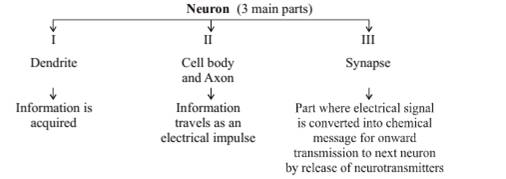
The axon (nerve fibre) transmits electrical signals from the cell body. The dendrites are branching fibres that receive electrical signals from other neurons. The shape of a neuron is determined by the job it does.

Synapse :The point of contact between the terminal branches of axon of one neuron with the dendrite of another neuron is called synapse.
REFLEX ACTION
Reflex action is an automatic response of the body to a stimulus. e.g. withdrawal of hand, knee jerk etc. on touching a hot plate.
Reflex arc : The pathway taken by nerve impulses in a reflex action is called reflex arc.
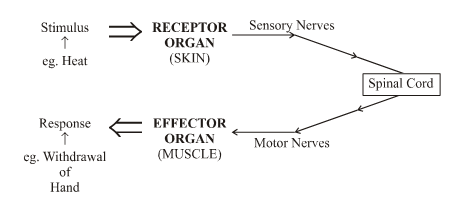
- Voluntary means it is under the control of a person (e.g. writing)
- Involuntary means it is not under the control of a person. (e.g. heartbeat)
Mechanism of Reflex action: A reflex mechanism involves a receptor organ, an effector organ, and some type of communication network. When a sensory receptor is stimulated, signals pass from it along a sensory neuron to the spinal cord. The message travels out of the spinal cord along a motor neuron to the effector organ (e.g., a muscle or a gland), which shows the response. Such a pathway is called a reflex arc. In most cases, however, the basic physiological mechanism behind a reflex is more complicated than the reflex arc theory would suggest. Additional nerve cells capable of communicating with other parts of the body (beyond the receptor and effector) are present in reflex circuits.
HUMAN NERVOUS SYSTEM : The nervous system of vertebrates (including humans) is divided into the central nervous system (CNS) and the peripheral nervous system (PNS). The (CNS) is the major division, and consists of the brain and the spinal cord. The spinal canal contains the spinal cord, while the cranial cavity contains the brain.


- Human Brain : It is enclosed in cranium (brain box) and is protected by cerebrospinal fluid which acts as a shock absorber. Human brain has three major parts or regios : (a) Fore-brain (b) Mid Brain (c) Hind Brain.
(a) Fore-brain(CEREBRUM)
Most complex/specialized part of the brain is Cerebrum or the forebrain.
Functions
1. Thinking part of the brain
2. Control the voluntary actions.
3. Store information(Memory)
4. Centre associated with HUNGER
5. Receives sensory impulses from various body parts and integrates it
(b) Mid Brain
It connects the fore-brain with the hind-brain. It is the portion of the central nervous system associated with vision, hearing, motor control, sleep/wake, arousal (alertness), and temperature regulation.
(c) Hind-Brain

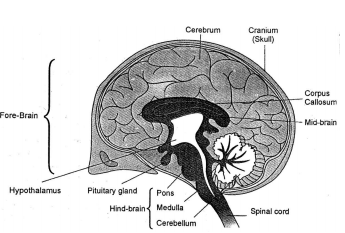
- Brain : The human brain is the command center for the human nervous system. It receives input from the sensory organs and sends output to the muscles. The human brainhas the same basic structure as other mammal brains, but is larger in relation to body size than any other brains
- Brain is protected by a fluid called cerebro-spinal fluid which acts as shock absorber. It has several layers called MENINGES.
- Spinal Cord : Spinal Cord is enclosed in Vertebral column.
COORDINATION IN PLANTS :
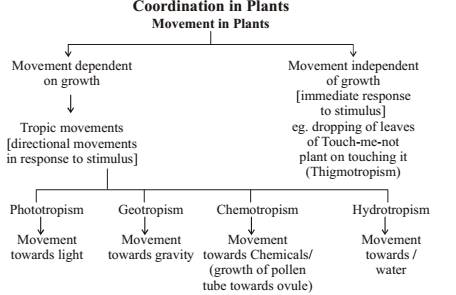
HORMONES are chemical compounds which help to coordinate growth, development and responses to the environment.
- Plant Hormones : Main plant hormones are :
(a) Auxin: Auxin is a plant hormone produced in the stem tip that promotes cell elongation.
(b) Gibberellin : Gibberellins (GAs) are plant hormones that regulate growth and influence various developmental processes, including stem elongation, germination, flowering, enzyme induction, and leaf anf fruit senescence(falling).
(c) Cytokinins : Cytokinins (CK) are a class of plant growth substances (phytohormones) that promote cell division, or cytokinesis, in plant roots and shoots. They are involved primarily in cell growth and differentiation, but also affect apical dominance, axillary bud growth, and leaf senescence.
(d) Abscisic acid :Inhibits growth, cause wilting of leaves. (Stress hormone).It promotes the closing of stomata (during adversed rough condition) their by reducing the water loss.
HORMONES IN ANIMALS
- Hormones : Hormones are the chemical substances secreted by the endocrine glands and transmitted by the blood to the tissues on which it has a specific effect.
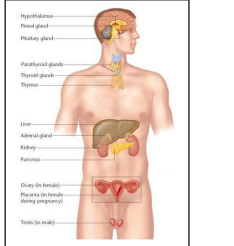
| S.no | Harmone | Endocrine Gland | Location | Functions |
| 1. | Thyroxin | Thyroid | Neck/Throat region | Regulation of metabolism of carbohydrates, fats and proteins. |
| 2. | Growth harmone | Pituitary ( master gland) | Mid brain | Regulates growth and development. |
| 3. | Adrenaline | Adrenal | Above both kidneys | Regulation (increasing) of blood pressure, heart beat, carbohydrate metabolism (during emergency). |
| 4. | Insulin | Pancreas | Below Stomach | Reduces and regulates blood sugar level. |
| 5. SEX Hormone |  |
 |
Genital/lower Abdomen area | Changes associated with puberty (sexual maturity) |
Iodised Salt is Necessary because thyroid gland needs iodine to make thyroxine which helps in regulating the metabolism of carbohydrates, fats and proteins. Deficiency of iodine cause a disease called goitre.
EXAMPLE :
Diabetes
Cause : It is due to deficiency of Insulin hormone secreted by Pancreas that is responsible to lower/control the blood sugar levels.
Treatment : Common diabetes can be controlled by medicine but in severe cases. Injections of insulin hormone are given to the patients.
Feedback Mechanism
The excess or deficiency of hormones has a harmful effect on our body. Feedback mechanism makes sure that hormones are secreted in precise quantities and at right time.

Control and Coordination class 10 Notes
- CBSE Revision notes (PDF Download) Free
- CBSE Revision notes for Class 10 Science PDF
- CBSE Revision notes Class 10 Science – CBSE
- CBSE Revisions notes and Key Points Class 10 Science
- Summary of the NCERT books all chapters in Science class 10
- Short notes for CBSE class 10th Science
- Key notes and chapter summary of Science class 10
- Quick revision notes for CBSE board exams
CBSE Class-10 Revision Notes and Key Points
Control and Coordination class 10 Notes. CBSE quick revision note for Class-10 Science, Chemistry, Maths, Biology and other subject are very helpful to revise the whole syllabus during exam days. The revision notes covers all important formulas and concepts given in the chapter. Even if you wish to have an overview of a chapter, quick revision notes are here to do if for you. These notes will certainly save your time during stressful exam days.
- Revision Notes for class-10 Mathematics
- Revision Notes for class-10 Science
- Revision Notes for class-10 Social Science
- Revision Notes for class-10 English Communicative
To download Control and Coordination class 10 Notes, sample paper for class 10 Mathematics, Social Science, Science, English Communicative; do check myCBSEguide app or website. myCBSEguide provides sample papers with solution, test papers for chapter-wise practice, NCERT solutions, NCERT Exemplar solutions, quick revision notes for ready reference, CBSE guess papers and CBSE important question papers. Sample Paper all are made available through the best app for CBSE students and myCBSEguide website.
- Chemical Reactions and Equations class 10 Notes Science
- Acids Bases and Salts class 10 Notes Science
- Metals and Non-metals class 10 Notes Science
- Carbon and its Compounds class 10 Notes Science
- Periodic Classification of Elements class 10 Notes Science
- Life Processes class 10 Notes Science
- Control and Coordination class 10 Notes Science
- How do Organisms Reproduce class 10 Notes Science
- Heredity and Evolution class 10 Notes Science
- Light Reflection and Refraction class 10 Notes Science
- Human Eye and Colourful World class 10 Notes Science
- Electricity class 10 Notes Science
- Magnetic Effects of Electric Current class 10 Notes Science
- Sources of Energy Current class 10 Notes Science
- Our Environment class 10 Notes Science
- Management of Natural Resources class 10 Notes Science

Test Generator
Create question paper PDF and online tests with your own name & logo in minutes.
Create Now
Learn8 App
Practice unlimited questions for Entrance tests & government job exams at ₹99 only
Install Now